2019
Viatcheslav Moshe Kantor
To my loved ones, living and gone
CLIMBING THE KANRIDGE
A journey through the space of Secure Tolerance
A Film Synopsis for followers
We do not live for the sake of Tolerance and Security. We live for our own sake, and we want to have a longer, better life. Our quality of life, our wellbeing, is important to us. We are concerned that the quality of life we enjoy today will not be possible for us or our children in the future. This fear is an important source of insecurity. Let us try to figure out how we could counteract these fears and improve our wellbeing (eventually).
In this introduction I assume that Security and Tolerance are two states of a society [1] (denoted by variables S and T) that may be influenced by many factors.
Specifically, Security is a state when a society and a nation are protected from various threats. So security depends on many factors, such as appropriate levels of military strength and law enforcement, country’s legal system, international agreements with other countries, socio-economic conditions, and other national and international factors.
Tolerance is the ability of society to incorporate and respect the interests and values of social groups and movements outside established social norms. Internally, tolerance guarantees the freedom for all members of society to practice their chosen way of life. Externally, it implies the willingness to accept a variety of political regimes. In neither case can tolerance be unconditional or unlimited. The goal is to develop policies that enhance both tolerance and security whenever this is possible.
Secure Tolerance is the state corresponding to optimum levels of Security and Tolerance. This balance, which is specific to each nation and historic time period, provides the framework in which progressive public development policies, also referred herein as responsible development policies, can be effectively carried out locally, nationally and on a wider scale, in regional or global relations. Such responsible development policies can be related to socio-economic indices of Wellbeing (or Quality of Life) as discussed next.
Wellbeing (Quality of Life; K) is defined for the purpose of this research by eleven indices.[2] This selection is somewhat subjective and may be modified during future research.
These eleven proposed indices are:
- Ability to prevent war (K1), the primary index
- Ability to prevent radicalism, including terrorism, racism, xenophobia and antisemitism (K2)
- Ability to provide quality healthcare to all population groups, including mental health services for families and children (K3)
- Ability to maintain economic growth (K4)
- Ability to maintain society’s dignity, including ethics education (K5)
- Ability to develop science and education (K6)
- Ability to manage and control immigration (K7)
- Ability to protect the environment and natural resources (K8)
- Ability to adapt to structural ethnic changes in the society, including formation of stable ethnic entities (K9)
- Ability to implement and manage technological innovations, including management of accelerating technological revolutions (K10), and
- Ability to protect the interests of young generation (K11).
Each of the K indices depends on a set of metrics that provide security (S) and ensure tolerance (T). These metrics may vary (i.e., different for each country/society). Hence, selection of particular set of metrics for S and T, for a given K index, will be the result of value judgement.
For example, consider the ability to prevent war (index K1). For this index, security S1, can be understood as Defence Capacity, or as a set of measures to ensure military security, and T1 as Consideration of Opponent’s Interests and Flexibility for Compromises. Of course, interpretation of S and T would be quite different for all other K indices.
Let us define long-term social development focusing on such quality-of-life indices as responsible governance, and define appropriate development as responsible development, – and we have taken the task of choosing the indices very RESPONSIBLY!
K indices may describe country’s external and/or internal challenges. For example, K1, describing the capacity to prevent war, reflects an external challenge, whereas K11, protecting the interests of young generation, undoubtedly reflects internal problems. K7 (immigration policy) has a mixed nature, as it involves both internal and external challenges.
Indices similar to K1 through K11 are described here as “quality indices for governance of responsible development”, because this set of indices reflects, in my subjective view, long-term social interests (at this time). However, it may be possible that some indices are not essential, or that some other essential indices have been left out, then the development determined by this set can not be regarded ‘responsible’. The purpose of future research is to analyse the significance of the K indices and propose other indices and/or their combination.
Future research will focus on “Kanridge building”, i.e. estimating different Kanridge functions K(S,T) from available (empirical) data. This research involves:
(1) specification/selection of two input variables (S and T) and a single (real-valued) output variable K, appropriate for particular quality-of-life index.
(2) description of available empirical data, where data samples are in the form of triplets or (K,S,T)-values
(3) estimation of unknown function K=F(S,T) from empirical data (2). This problem is known as ‘regression estimation problem’ in statistics and machine learning.
(4) various interpretations of Kanridge function estimated in (3), including discussion on the size of ST region, effect of public policies on Kanridge etc.
Next, for each of the K indices we conduct a qualitative analysis of its dependency on the T and S variables (Figure 1).
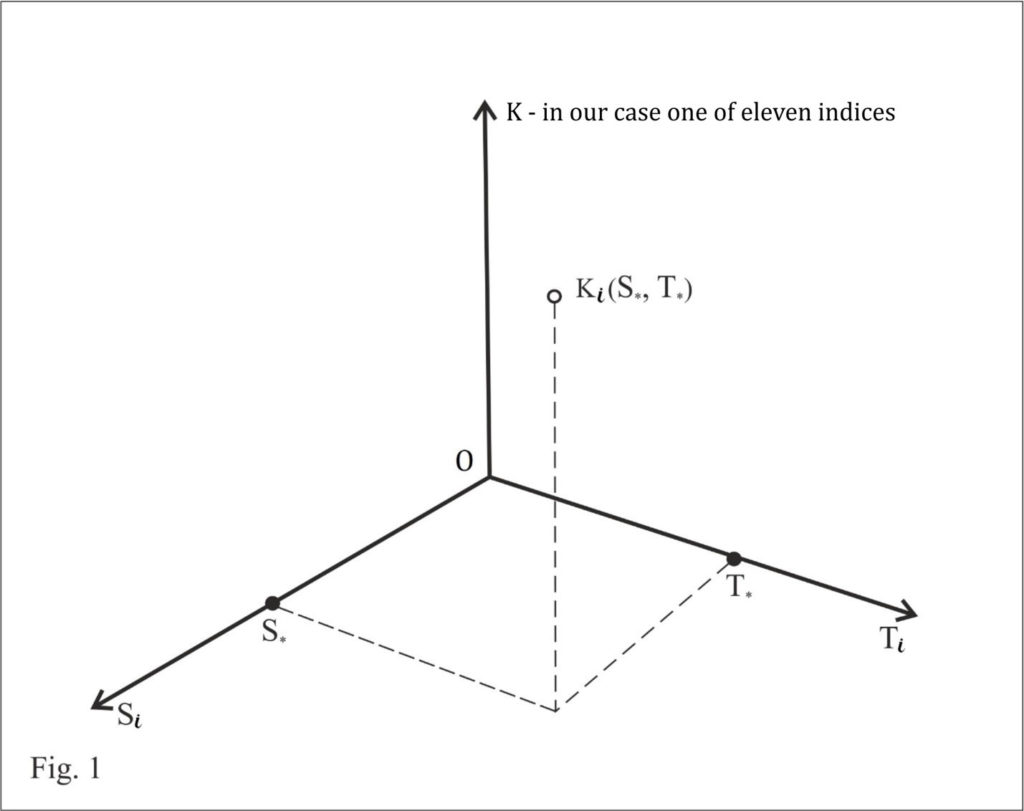
Let us assume that any point on the OTi and OSi axes (Figure 1) corresponds to measures and states that can be more or less secure or tolerant, meaning that they could be compared, and projected correspondingly on axes OTi and OSi. All of the Ki indices depend on the Ti and Si variables.
T and S mean a SET of national or international measures and states to which a certain K value corresponds.
Naturally, K, T and S values are continually evolving and are defined by the changing historical context. These values change in the same way that individuals, societies, and governments react to any external impact.
Let us look at how each of these indices behaves with respect to the S (security) and T (tolerance) parameters.
Observation 1
Paradoxes of Security and Tolerance
Let us look at the behaviour of a K index solely as a function of security S, where tolerance T=0, and vice versa, solely as a function of T, where S=0, as shown in Figures 2 and 3.[3]

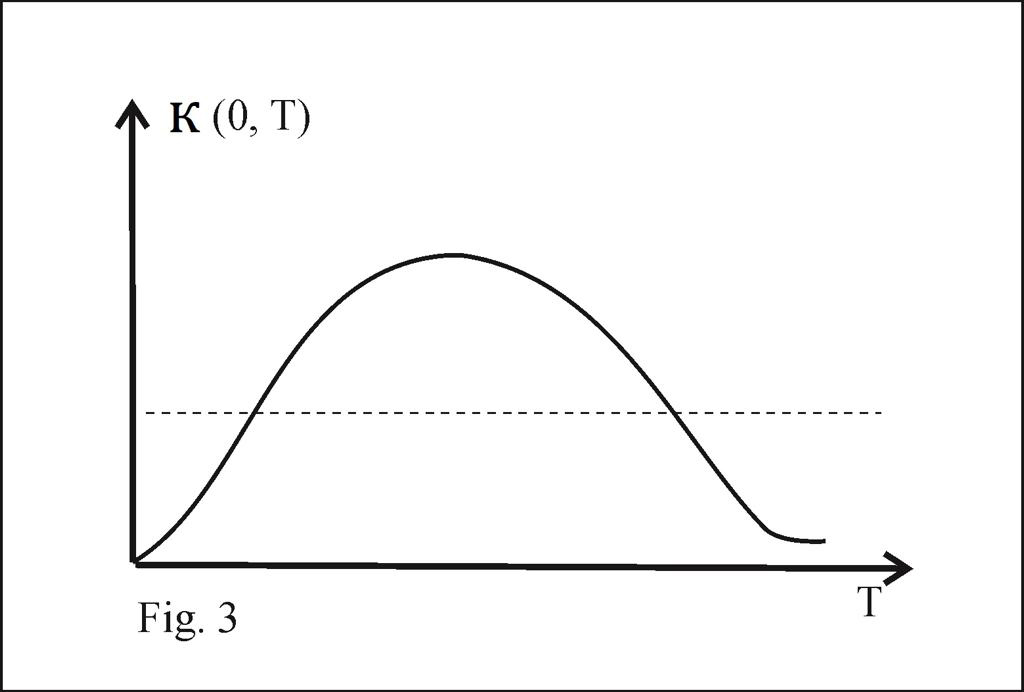
Initially, it might appear odd and paradoxical (Figures 2 and 3) that greater S and T values actually lead to deterioration in the quality of responsible governance of development, i.e. excessive tolerance (or excessive security) is as harmful as its shortage. But this paradox contains some important truth. Total security is impossible or self-defeating, because it implies giving arbitrary power to the state and thus increasing the level of insecurity for ordinary citizens. Total tolerance is impossible or self-defeating because it implies refusing to put restraints on the enemies of tolerance and thereby risking the future of tolerance itself. Combining total security with total tolerance is even more impossible, because it would mean compromising both.
Secure tolerance, on the other hand, means a combination of the two for which the K-value is increasing. This is an optimal point that we would like to identify and achieve.
We expect (qualitatively) similar dependency on T and S for all indices Ki (i=1-11).
Figure 4 shows a hypothetical 3D surface of the Ki index defined by variables S and T. In this instance, a flat “hump” turns into a 3D “ridge”.[4]
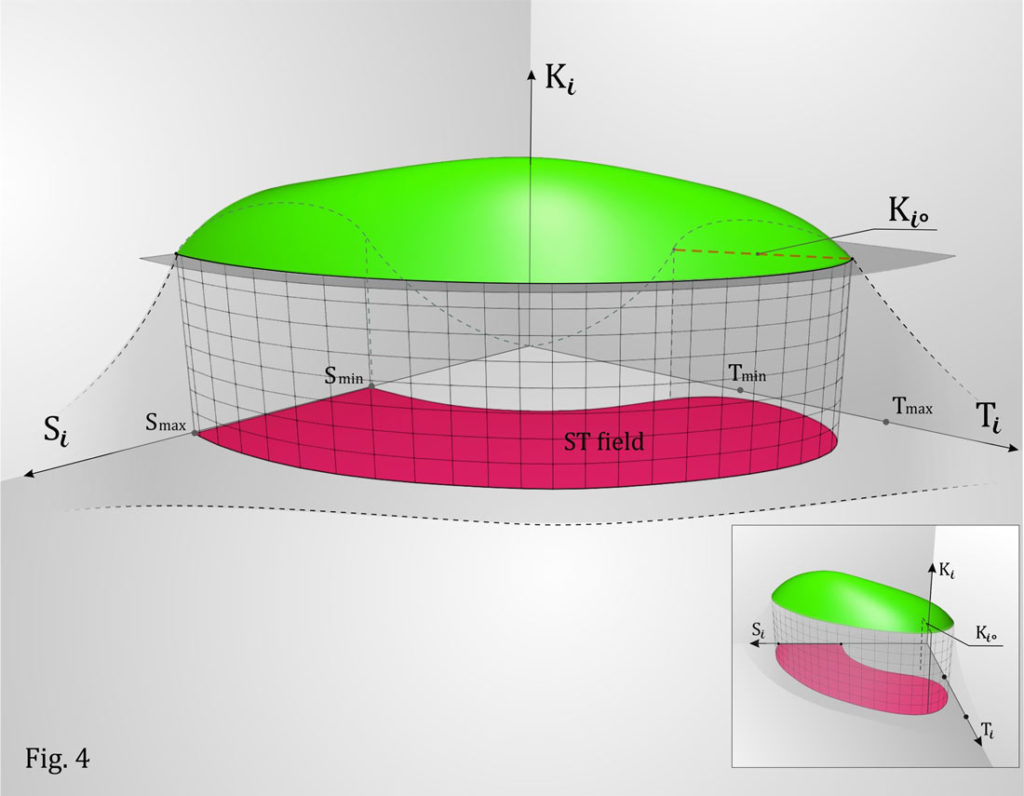
For example, consider dependence of index K1, the ability to prevent war, on security and tolerance.
K1, definitely the most important of the essential indices listed above – the ability to prevent war (threat of war) is a key element of national and international security. It presumes sufficient military capacity, the ability to prevent international and cross-border conflicts and settle them diplomatically, the ability to maintain arms control agreements and many other factors.
To a large degree, national security is a function of nation’s military capacity. However, this relationship is not linear. National security may weaken and fall below critical point if military capacity is either above or below a certain threshold. Excessive military capacity may threaten other nations, provoking them to build up their own military capabilities and form close alliances against a common enemy. During a crisis, fear may lead to pre-emptive strikes (as happened with Israel’s strike during the Six-Day War in 1967). In addition, building up excessive military capacity may undermine nation’s finances, which may negatively affect other of socio-economic indices and lead to social unrest.
On the other hand, when military capacity declines below a certain threshold, other countries might be tempted to apply political pressure, and, in extreme cases, even military force. If this happens, the nation finds itself vulnerable and defenceless.
At both ends of the spectrum, overall international security can be negatively affected by excessive or insufficient military capacity.
The same logic applies to tolerance. On the one hand, an extreme decline in tolerance, e.g., refusal to consider other countries’ interests and withdrawal from negotiations and agreements on disputed issues, all start to undermine the security of a country pursuing such policies because other nations may react by adopting tougher policies, including more radical and militaristic positions, leading to international confrontation, conflicts and wars.
On the other hand, excessive tolerance in foreign policy may empower other nations and non-state actors to act against the wellbeing of a tolerant nation (via, political and military pressure, proliferation of nuclear arms and carriers, escalation of international terrorism and other dangerous acts).This would produce conflicts and chaos, which may be fatal for national and international security.
The above example (using K1 index) demonstrates paradoxes inherent in both security and tolerance.
The author (being no mountaineer at all) finds his personal 12-year “ascent” of the “ridge” depicted in green on Figure 4 helpful for understanding the dynamics of wellbeing, security, and tolerance, and has named part of this ridge after himself – the Kantor Ridge, or, more briefly, Kanridge. We can also see in Figure 4 that the pink area defined by balanced values for S and T is the field of Secure Tolerance. Consequently, for each of the Ki indices, only appropriate part of the ridge where Ti and Si values provide sufficiently high level of Ki indices, may be called Kanridge. Figure 4 also displays univariate dependencies K(S, 0) and K(0, T) introduced earlier (under Observation 1) – these two dependencies are shown as two separate dotted lines. As evident from Fig. 4, the maximum values of univariate Kanridges K(S, 0) and K(0, T) are (usually) smaller than the maximum of bivariate Kanridge K(S, T). This observation suggests that an optimal region in ST-field, where Kanridge is large, depends on a pair of (S, T) values, rather than on optimally chosen single value.
Secure Tolerance (ST) is a region in two-dimensional space, which is affected by any public policy action. For example, consider the effect of US withdrawal from the INF Treaty on K1. This change in public policy will immediately trigger three (dynamic) processes:
– Change in the value of security S1
– Change in the value of tolerance T1
– Shrinking width of Kanridge 1 (K1) due to external pressure, in this case resulting in a sharp drop in society’s capacity to confront the threat of war. The effective surface of K1 shrinks similar to la peau de chagrin.
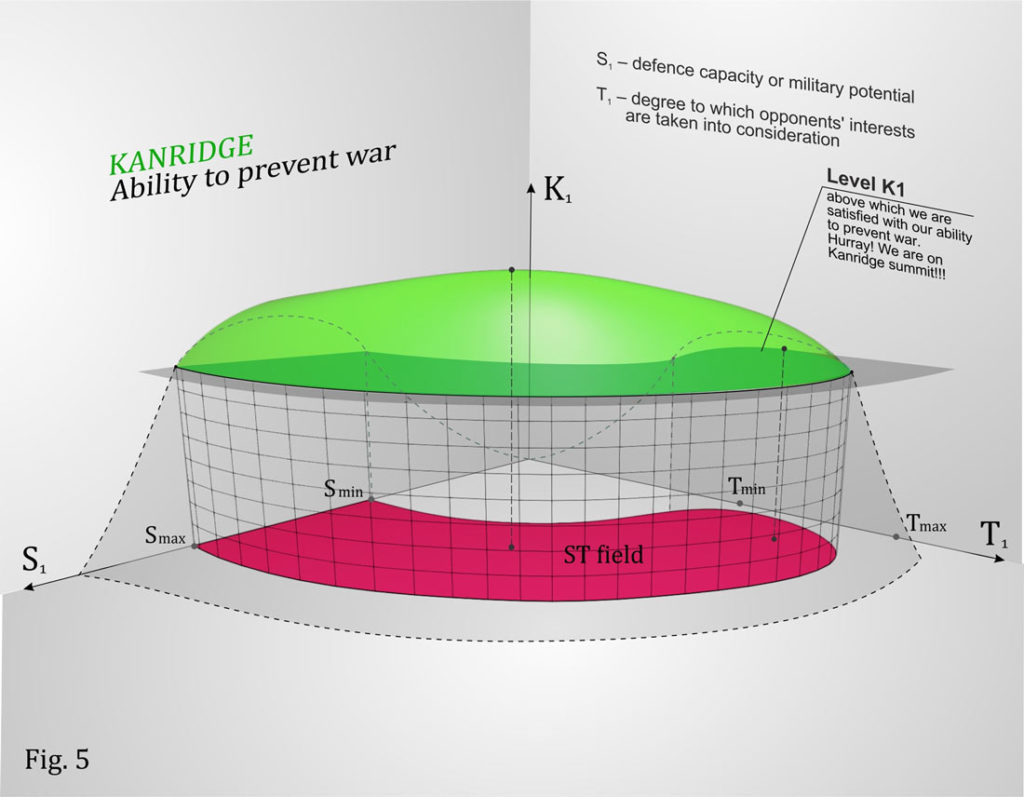
As Figure 5 shows, a complex and dynamic model of interactions between security and tolerance in the politics of an individual nation, assuming other states reciprocate, shows that the overall international environment should contain an overlapping space – the area of Secure Tolerance. It is highlighted in 3D green (this is Kanridge 1), and its 2D projection is the ST field. The 3D surface and ST field reflect beneficial conditions for ‘responsible governance of development’. In other words, the K1 index within Kanridge creates the most favourable conditions for peace, international cooperation, prosperity and development of countries and their communities – at each specific place and time.
Life on Kanridge is superior to life outside of it and it satisfies criteria of responsible governance and development. The goal of future research is to investigate Kanridge and ST fields for each of the eleven indices, to verify the thesis on their “ridge-like” dependency on S and T.
Examining how Kanridge changes over time, we see that during or immediately before a crisis (even worse, a catastrophe), Kanridge becomes a small peak with little room for living (Figures 6 and 7). We also see that the ST field becomes very narrow.

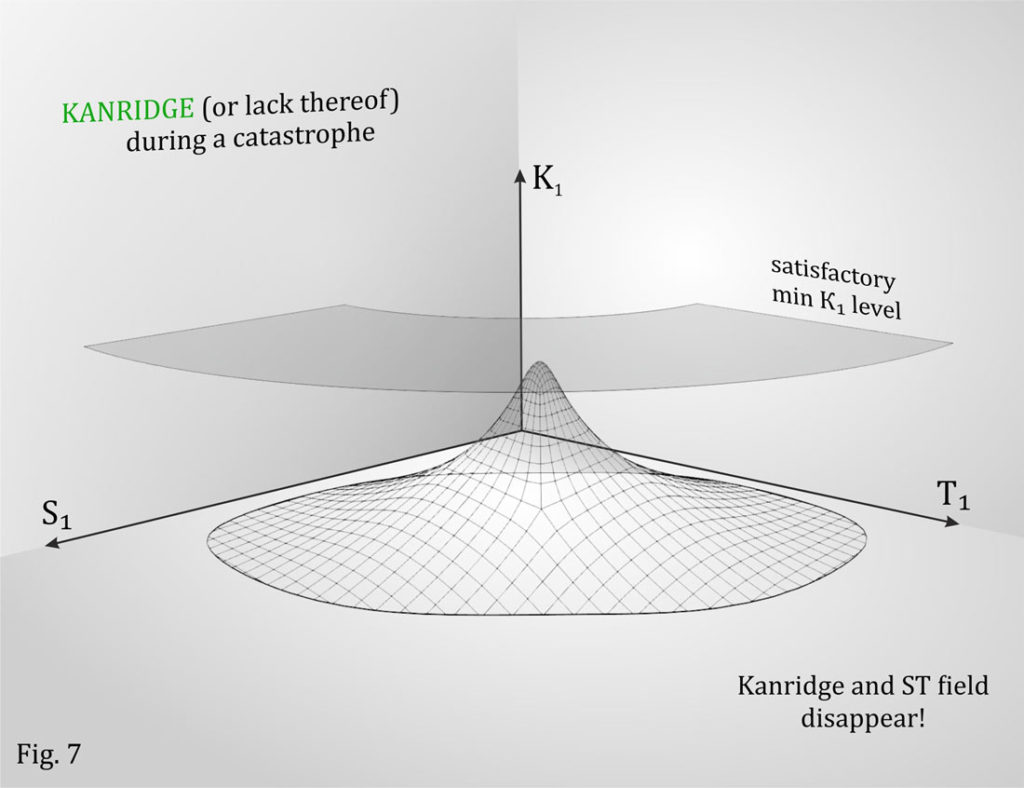
Once the crisis is over, Kanridge becomes flatter and expands, reaching the level required for peace and development, but in a new way (see Figure 8).
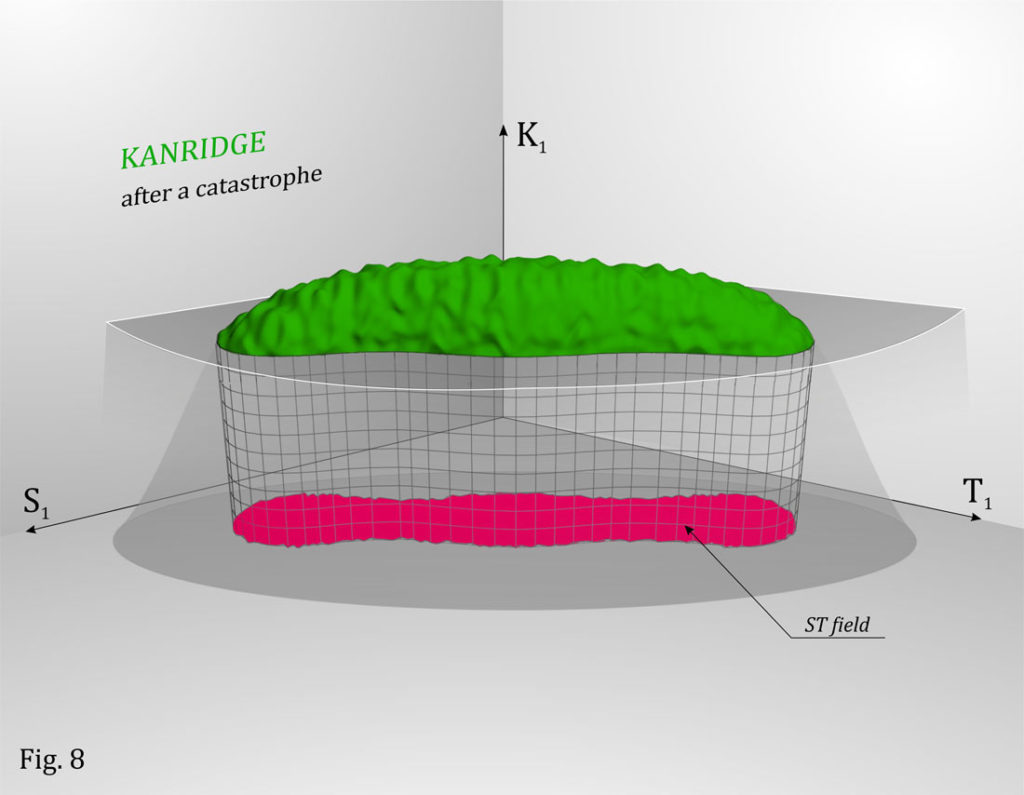
There is a Russian joke saying: “The camel has two humps because life is a struggle!”
Each Kanridge for a particular society has one hump. But if we look at the behaviour of Kanridges across different societies, their total 3D surface (as a function of the same T and S variables) will have multiple humps, and their secure tolerance fields may coincide and overlap. However, such interaction between societies will be discussed in detail later (see Figure 9 with 3 societies as an example).
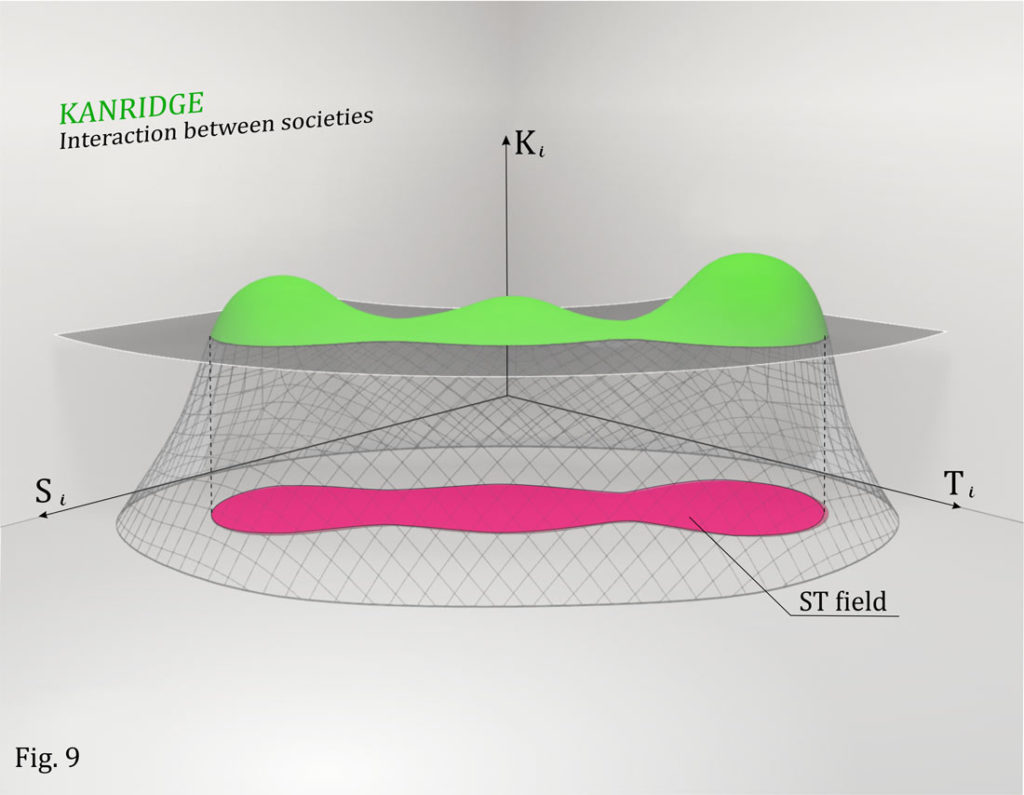
Now is the time to ask an obvious question: what could be the purpose of all these theoretical exercises with a hint of self-deprecation? What is the purpose of building Kanridge and seeking for a combination of responsible policies? Or, can we really convince religious radicals or neo-Nazis or the far left to change their mind? Can we stop populists from intentionally converting the naïve to extremism?
No.
We do not believe in utopia. However, we can clearly respond to the main challenges of changing normalcy, we can consolidate new electorate around progressive leaders and responsible policies, under the umbrella of a renewed Political Centre. We cannot re-educate our opponents, but we can defeat them by convincing our allies. The ideology of Secure Tolerance is the basis for this conviction.
The author fully shares the position of John Gray [5], who believes that moral values, unlike intellectual values, are poorly inherited. Even the most vital history lessons remain ignored and hidden in traditional media, even the most advanced ones. Without moral education on the consequences of our actions (or inactions), a society will always spiral down into new crises of anarchy, dictatorship and extremism (Figure 10).
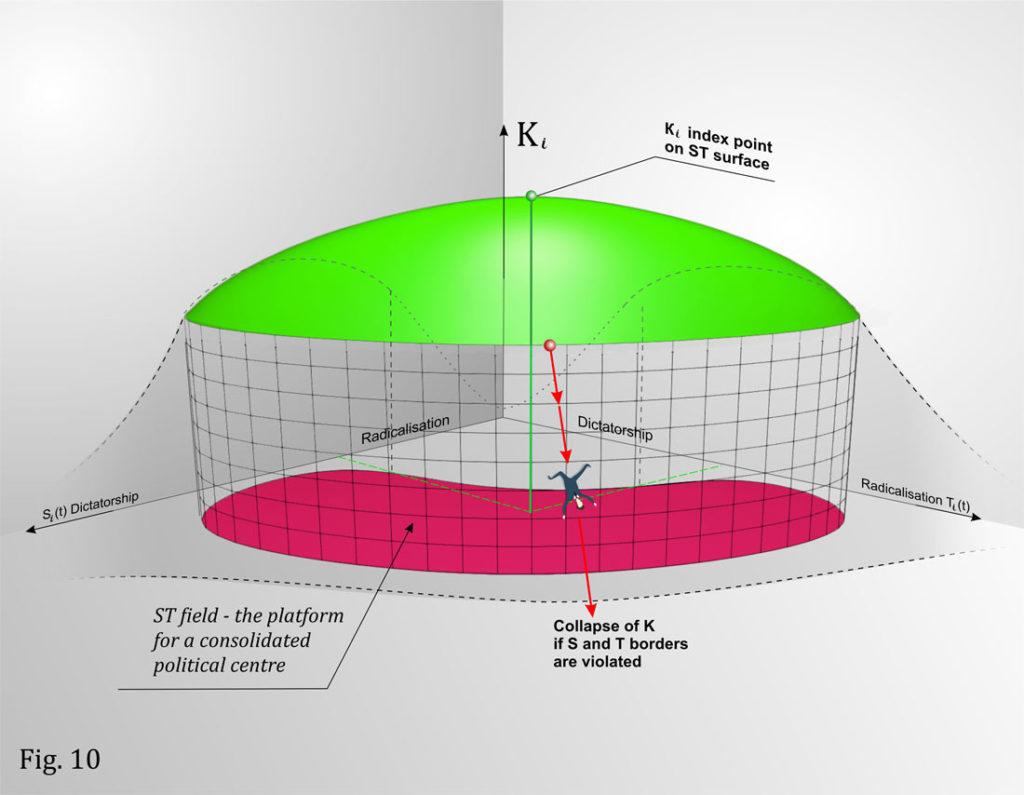
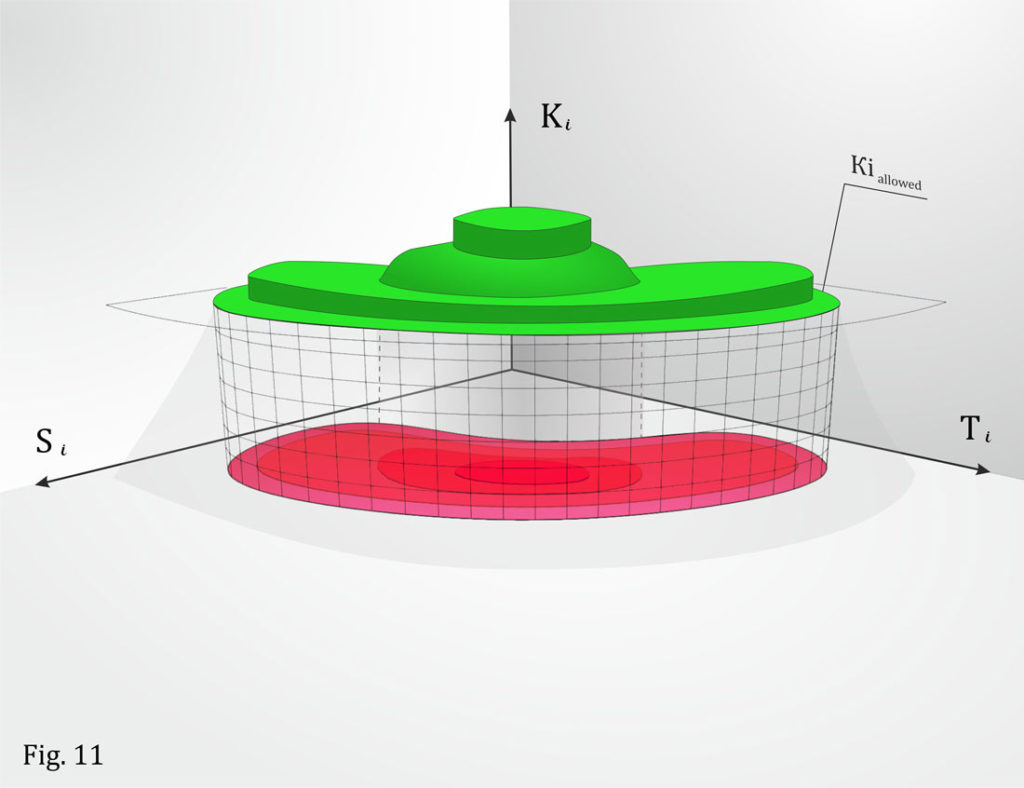
Near the boundary values of Ki allowed, the wellbeing is maintained by a strict social contract [6] consisting of legal agreements and rules (laws), both on national and international level.
Deep inside the ST field, the value of Ki is quite high and can be maintained by existing national customs and traditions.
Any Kanridge can be sliced into “terraces”, i.e. such layers of the Kanridge surface where Ki remains unchanged despite changing Ti and Si.[7]
A terrace usually corresponds to strict contractual obligations assumed by one or more parties (we can describe the terrace as a strict social contract).
In contrast to slicing Kanridge into terraces or layers, certain regions inside the ST field have mild slopes where small changes in Ti and Si result in gradual changes in Ki. This scenario reflects natural, not-man-made, behavioural trends in a society, when Ti and Si values stay within the ST field (see Figure 11), i.e. within the range of Ki variability.
We will call the social contract corresponding to these mild-slope areas a liberal social contract.
The author believes that building Kanridges can be universal. Of course, the author primarily has in mind the social model of Europe and its set of responsible development indices.
However, the approach remains the same for any country on any continent. For instance, for the majority of African countries, the primary index is the ability to withstand tribal conflicts, so that the desire of a ruling tribe to strengthen its position by enhancing various security (S) measures must not negatively affect the interests of opposing tribes (T).
The second African example concerns special sensitivity and blind confidence in the information presented in mass media. The African people are probably most gullible consumers of misinformation in mass media. Therefore, the ability to confront conflicts must be ensured by an optimal combination of enhanced control over the quality of information flow (S) and the freedom of expression (T).
Here is another example. Over the past decade, the index responsible for protecting the environment and natural resources has been of primary importance in China. However, even in this case, environmental K8 is defined not only by measures for conserving natureand natural resources (S8), but also by the ability to respect the society’s interest in developing production capacity (Т8).
The author hopes that once the concept of Secure Tolerance has been planted in the public domain, it will grow to the point that no country will ensure its long-term responsible development without respecting the interests and values of other countries, even if they are currently opponents. Here, the author relies on conclusions made by George Soros and Vladimir Cherkassky.[8]
Soros argued that social systems are different from natural systems (described by natural science). That is, physical world operates according to some objective laws, which are independent of our knowledge about them. Social systems are fundamentally different, in the sense that humans are not just passive observers of a system, but also active participants. So our present knowledge about a social system can, in fact, change its future behaviour. Simultaneously and naturally at the same time, our understanding of social systems is inherently imperfect or flawed.
The general meaning of this introduction can be formulated quite simply: Кi in Kanridge is always higher than the height of Ki in a two-dimensional space depending particularly on Si and Ti Or

Life is complex and simple at the same time.
Therefore, we will put it even simpler: everyone will become stronger if we strengthen ourselves by showing more tolerance, i.e. respect for others, including our opponents. Only those who categorically reject tolerance can be excluded from its scope. Secure tolerance is beneficial, and indeed necessary, for all societies.
The author and his colleagues will be happy if the reader of this essay climbs Kanridge and says, “It was not easy, but life here is truly beautiful, and I want to stay here longer, maybe forever!”
Dear reader, if you find some parts of this brief essay too complicated, feel free to skip them and read on. At the very least, it will be enough if you read the beginning and the end.
If, however, you are a filmmaker, especially if you decide to make a full-fledged movie out of this synopsis, a movie that would be understandable to a politician or a radical or a person in the street, we ask that you read the entire text.
Researchers – Kanridge-builders who will participate in a competition to build the eleven best Kanridges cannot skip the full text either. In the building process, they will be able to demonstrate their profound professional knowledge of their field, on the one hand, and strict compliance with the author’s methodology on the other hand.
Exactly nine months after signing contract with filmmakers and researchers, the author commits himself to informing readers about the results of building Kanridge City.
In addition to building one of the eleven best Kanridges, each researcher may also propose his or her own vision of synergy between Security and Tolerance.
The author feels immense gratitude towards his colleagues, who have walked the long, thorny path to the top of Kanridge with him: General Vladimir Dvorkin, Academicians Alexey Arbatov and Alexander Dynkin, Lord Michael Levy, former Prime Minister Tony Blair, economist and ECTR director Ireneusz Bil, philosopher John Gray, mathematician and professor Vladimir Cherkassky, and historians Antony Beevor and Timothy Snyder.
I hope we will continue our road together.


